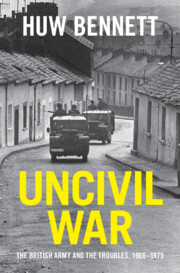Book contents
- Uncivil War
- Cambridge Military Histories
- Uncivil War
- Copyright page
- Dedication
- Contents
- Figures
- Maps
- Tables
- Illustrations
- Abbreviations
- Introduction
- 1 Baggage
- 2 The Army’s Short-Lived Ulster Honeymoon
- 3 Escalation and the Erosion of Impartiality
- 4 Edward Heath’s Bid for Victory
- 5 The Road to Bloody Sunday
- 6 The Most Deadly Year
- 7 Strategy in the Shadow of Loyalist Power
- 8 We Cannot Envisage Peace
- Conclusion
- A Note on Sources
- Acknowledgements
- Notes
- Bibliography
- Index
Introduction
Published online by Cambridge University Press: 03 August 2023
- Uncivil War
- Cambridge Military Histories
- Uncivil War
- Copyright page
- Dedication
- Contents
- Figures
- Maps
- Tables
- Illustrations
- Abbreviations
- Introduction
- 1 Baggage
- 2 The Army’s Short-Lived Ulster Honeymoon
- 3 Escalation and the Erosion of Impartiality
- 4 Edward Heath’s Bid for Victory
- 5 The Road to Bloody Sunday
- 6 The Most Deadly Year
- 7 Strategy in the Shadow of Loyalist Power
- 8 We Cannot Envisage Peace
- Conclusion
- A Note on Sources
- Acknowledgements
- Notes
- Bibliography
- Index
Summary
Perceptions about the British Army in Northern Ireland became fixed in a little over ten minutes on Sunday 30 January, 1972. The conflict’s most iconic image doesn’t feature any soldiers. A hunched-over priest waves a bloody handkerchief as 17-year-old Jackie Duddy is carried away. He was one of thirteen people killed by paratroopers on Bloody Sunday, an event central to how Britain’s actions in Northern Ireland are judged. The legacy of that day, like many others marked by grief, is still felt in Northern Ireland’s present. What happened, and why and how the past might inform the future, are questions regularly and publicly discussed. More than 250,000 soldiers served in Northern Ireland between 1969 and 2006. (See Map 1.) Yet the campaign is treated in Britain with nervous silence. There is no official history; only passing references are to be seen at the Imperial War Museum and the National Army Museum. In British memories the violence in the 1970s melds into despondency about a decade rife with ‘industrial conflict, inflation and unemployment’.
- Type
- Chapter
- Information
- Uncivil WarThe British Army and the Troubles, 1966–1975, pp. 1 - 12Publisher: Cambridge University PressPrint publication year: 2023

